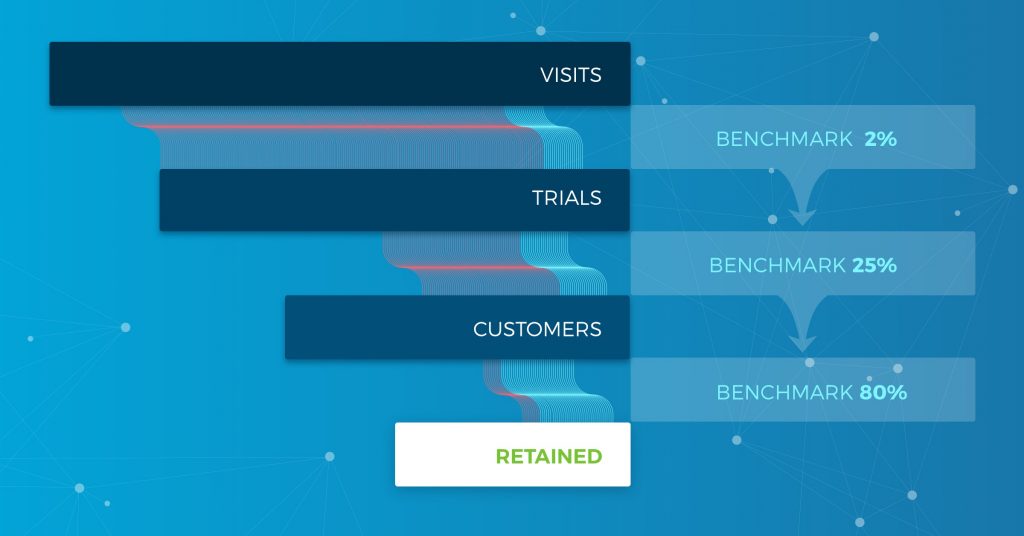
Do you know if your product’s Free Trial is hitting industry conversion benchmarks? If not, you could be leaving a lot of money on the table. This article will help you determine just how much is being potentially lost and make sure you’re picking the right type of trial for your customer acquisition model.
In Starship Troopers, author Robert A. Heinlein said, “There's no such thing as a free lunch.” In other words, there’s always a price to pay, even if it seems free. This is equally true when getting something for free as it is when giving something for free. As SaaS business decision-makers, figuring out how to use “free” in your conversion funnel is not easy. And mistakes can be costly.
If you’re leveraging a trial as your primary customer acquisition strategy, then your definition of a “free trial” can be the crux of your product’s success. In this article, we’ll explore the two main trial types, how to leverage them, and how to know if your trial conversions are hitting benchmark numbers.
Side note: If you are looking to know if you should be doing a demo or a free trial check out "SaaS: Free Trial, Demo or Neither?"
A Tale of Two Trials: Opt-in Trials vs. Opt-out Trials
When it comes to trials there are two primary approaches in the SaaS market, opt-in vs opt-out. Let’s take a look at the components of each.
Opt-in Trials (Standard Free Trials)
This is the traditional free trial you most likely default to. Signing up does not cost a dime and allows users to quickly immerse themselves in your product before committing to a purchase.
There is only one type of opt-in free trial:
- Standard Free Trials (Opt-in): This is defined by the need to manually opt-in at the end of your trial to become a paying subscriber. In other words, you don’t get automatically upgraded when the trial ends.
The Challenge: When it comes to standard free trials, the biggest hurdle is getting the user to the aha moment (delivering on the promise of your business) during their trial that ultimately compels them to upgrade.
Opt-out Trials
Here prospective customers are asked to enter their credit card details and either pay a small fee upfront or, more commonly, gain access without a charge but require your credit card details. But in both cases, if they don’t opt-out before the trial period ends, then they will be charged and automatically become a paying customer.
Let's look at the two types of opt-out trials:
- Opt-out Free Trials: This is when credit card details are required in order to access the trial and you have to opt-out in order to not become a paying subscriber. If you do not actively opt-out at the end of the trial you will be automatically upgraded to a paying subscriber.
- Opt-out Paid Trials: This is when a small fee is charged upfront in order to access the trial (or when the first month is charged but can be refunded within the designated trial period). Again, if you do not actively opt-out at the end of the trial you will be automatically upgraded and become a paying subscriber.
The Challenge: Opt-out trials’ biggest challenge is getting visitors to sign up for a trial in the first place since it requires an immediate commitment.
Why Should You Care? Well, They Convert Differently
Let’s talk about how each trial type converts and give a few examples to understand the potential outcomes if each trial type were to meet our trial conversion benchmarks.
First, let’s define what we are calling benchmarks.
We are considering benchmarks to be the ideal numbers that we know are achievable from our experience. Here are a few definitions to clear things up a bit:
- Industry Benchmarks - the ideal number that if matched or surpassed we consider your trial to be optimized.
- Industry Benchmarks Range - the range that shows the low end and high end of an optimized trial.
- Industry Averages - the average conversion rate within the industry. Note: This does not determine that if you business meets an industry average that it is ideal.
For this article, we will be concentrating on #1, Industry Benchmarks. This will be a single conversion rate number that falls in the middle of the benchmark range that we consider ideal.
We have gathered our benchmark data from working with hundreds of SaaS businesses along with agreeing with a few trusted articles.
- Quora - This post concentrates on the Visitor to Trial conversion rates. We believe 2% is an accurate number from our experience on a Standard Free Trial. However, they will decrease with an Opt-out trial type.
- Sixteen Ventures - This article mainly focuses on Trial to Paying Customer conversion rates.
- Totango - This resource is a bit dated and we don’t agree with all of the data but we do agree with the number of customers retained after 90 Days.
So let’s get down to it and look at how each trial type converts. To show an example we need to start with the number of unique visits to your site. For this example we will start with 10,000 visitors:
Key Resource:
Use this SaaS Free Trial Benchmarks Calculator to plug in your own numbers and find out if your product’s trial conversion rates meet industry standards based on your current acquisition model.




